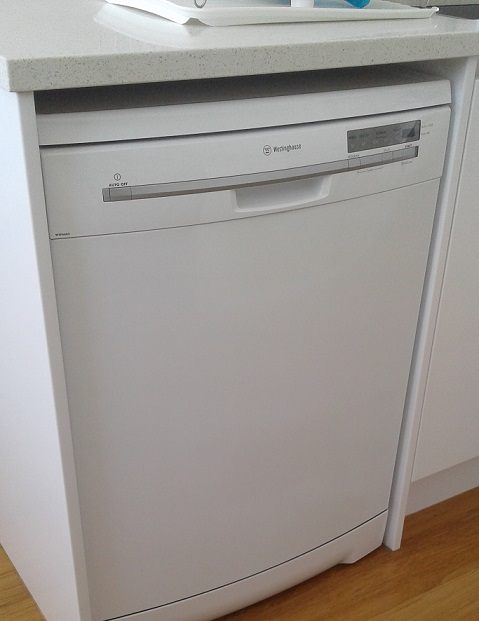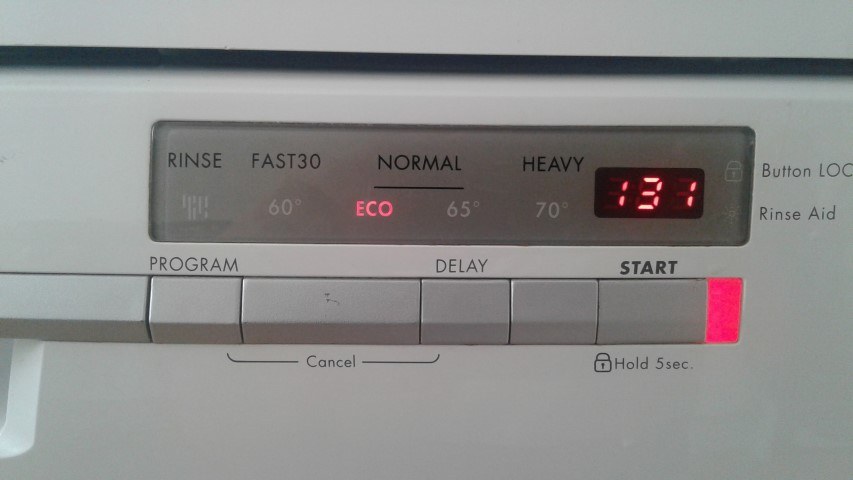After testing our fridge last week. Now I am interested in dishwasher energy consumption.
- How much power does a standard family dishwasher use?
- How much does each load cost?
- Should I be using the Eco mode? Well, it depends…
Measuring Dishwasher Energy Consumption
Our family dishwasher is a freestanding Westinghouse WSF6602WR purchased secondhand from Trademe. We think manufactured in 2015.
It has an Energy Star rating of 3* and a water efficiency rating of 4.5*.
I tucked the power monitor away under the sink and left it collecting data for a week of normal usage. Taking a peek every now and then to see what the latest load of dishes used.
Dishwasher Energy Consumption Results
With two young kids and me working from home, we create a fair amount of dishes (mainly cups left all over the show!) each day. So the dishwasher goes on most nights.
After a week of use, our dishwasher had used 8,712 Wh of power, which equates to 454 kWh (units of power) per year.
In dollar terms:
- 38c per day running cost
- $11.70 per month, and
- $140 per year.

Dishwasher Energy Consumption Per Load
Our dishwasher has a few wash settings. We usually just jam it on at the default 65°C option which works well.
On the default option, the unit reliably uses 1.4 kWh of energy, or approx. 43c per wash.
This was actually a lot more than I thought a dishwasher might use. As there is only the cold water pipe connected to the dishwasher, I would guess the bulk of the power is used to first heat the water and then to dry the dishes at the end.
Standard Mode vs Eco Mode
While I had a logger set up, we decided to try out the Eco mode.

On Eco mode, the dishwasher only used .75 kWh. A reduction of some 47% in power consumption and I assume it also used less water. Very impressive.
However, the washing results were less than impressive from a cleaning perspective 🙁
Mrs. Power Guy gave the wash a rating of 8 / 10 compared to the default mode. Not terrible, but not ideal and we had to rewash some of the dishes.
What we concluded is that if the dishes were pretty clean going in, then the Eco mode is a definite energy (and environment) saver. If, like us, you pack the dishwasher to the gunnels and rely on it to do a good job… then stick with normal mode.
Saving Money on Dishwasher Running Costs
The options I use to look at lowering the running costs of an appliance are (a) modify our behavior (b) modify the appliance (c) replace the appliance.
Modify our Behaviour
There are definite savings to be achieved by using Eco mode and potentially the quick wash, which we didn’t try.
If we did a good rinse on all dishes and solely used Eco mode, I think we would lower our annual power bill by around $65.
Modifying our Dishwasher
I am not even going to consider this, at risk of divorce. There are enough wash mode options available already.
Replace It!
If we were going to replace the dishwasher with the aim of saving money, a higher Energy Star rating would be a good thing to look for.
For example, an entry level Bosch freestanding unit has a 4.5* rating and according to their website uses 205 kWh per year. It’s unclear how this is calculated, but taking this as gospel we would save around $75 per year on power.
There are also lower power Eco wash modes, with the Bosch doing a 45°C option at around 17c per wash.
However… the price for this efficiency is some $2500. Ouch. Like the fridge I also tested, it doesn’t make economic sense to replace a new-ish functioning appliance (with Eco options) for the sake of power savings alone.
Conclusions
This has for me been a very interesting exercise, as I would never have guessed that dishwashers could use 1.4 kWh of power, approx $0.43, per wash. This is on top of the water usage.
My main takeaway is that should we look for an upgrade in the future I’ll be keeping my eye on the Energy Star rating.
In the meantime, a few Eco mode washes (when Mrs. Power Guy is not looking) will save us a dollar or three during the year.
– TPG


Nice item. We bought a new bottom of the range Haire dishwasher for for $350ish 4 years ago. From memory it uses a unit of power to heat the water and wash and a unit of power to dry.
It has a 10 minute eco wash with a slightly lower water temperature and no drying. We like this and always rinse our stuff first in cold water, cos of the plumber from hell. As soon as its finished we try to open the door and let the stuff air dry. Works well for us. If the wash is to deal with sunday roast loads we use the hotter normal wash and iff about will switch it off when it reaches the drying cycle.
I thought it was laundry machine